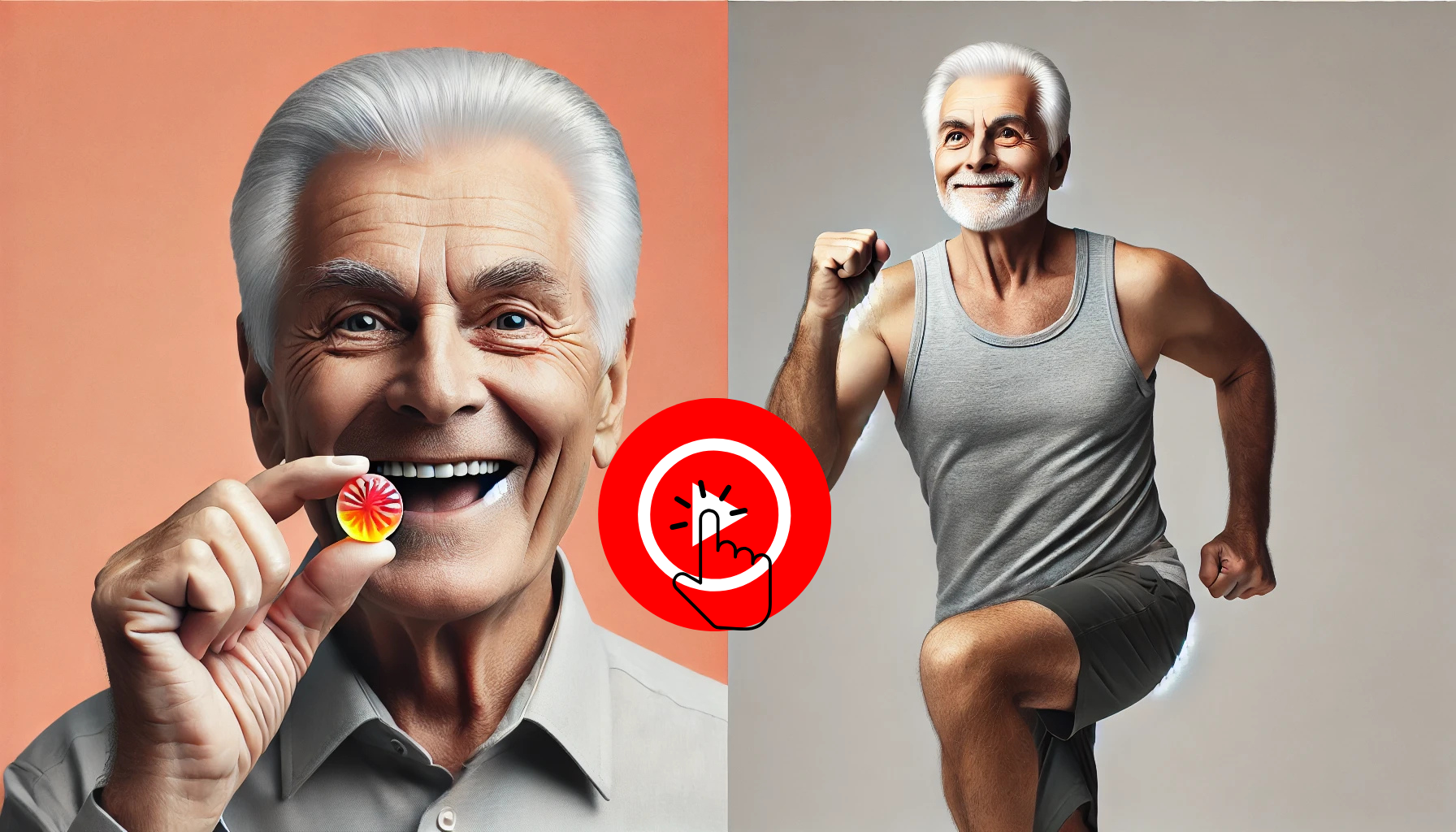Relief for aching joints: Natural solutions you need to know
Explore effective and natural remedies for aching joints that can help restore mobility and comfort.
Top Doctor Recommend This New Bоswеllіа & Cапаbіԁіоl Sweet to Avoid Knee Surgery
If you’re ready to take the first step toward a life free from the burdens of joint pain, there’s hope waiting for you. Imagine regaining your mobility and enjoying all the activities you love without discomfort. Many have transformed their lives, just like you can. Don’t let this opportunity slip away. Click the button below to watch a video that reveals a safe and natural solution that has helped thousands of seniors reclaim their freedom and joy. Your path to relief could start today, so why wait? Together, we can make a difference in your life.
Aching joints can feel like a heavy burden, especially as we age. For many, the simple act of getting out of a chair or tying shoelaces may become a monumental task. If you find yourself struggling with knee stiffness or facing the reality of arthritis in the knees, you are far from alone. This article dives deep into the roots of joint pain and presents natural remedies to alleviate discomfort, allowing you to reclaim your active lifestyle.
Understanding joint pain and its causes
Understanding joint pain is essential for anyone experiencing discomfort. Joint pain can arise from numerous sources, including arthritis, injuries, and cartilage damage. It is important to identify the specific cause of the pain to find effective solutions.
Arthritis is a common condition that affects millions. It causes inflammation in joints, leading to stiffness and difficulty with movement. Osteoarthritis is the most prevalent type, often associated with aging and wear-and-tear on joints.
Injuries, such as sprains or fractures, can also lead to joint pain. Cartilage damage can occur due to repeated stress or trauma. It is crucial to seek medical advice if you suspect an injury to minimize long-term damage.
Inflammation in joints can result from various factors, including infections or autoimmune diseases. In some cases, lifestyle choices contribute to joint health, such as diet and physical activity.
Maintaining a healthy weight is vital, as excess weight can increase pressure on knees and hips, exacerbating joint pain. Regular, low-impact exercises can improve joint function without causing additional strain.
How aging influences joint health

Aging has a significant impact on joint health. As we get older, our bodies undergo various changes that can affect our joints. One primary change is the deterioration of cartilage, the protective tissue that cushions the ends of bones in a joint. This can lead to pain and stiffness.
Another effect of aging is the decrease in synovial fluid. This fluid lubricates joints and helps them move smoothly. With less synovial fluid, joints may feel stiff and uncomfortable, especially after periods of inactivity.
Bone density also declines with age. This reduction can increase the risk of fractures and conditions like osteoporosis, making joints more vulnerable to damage. Regular weight-bearing exercises can help maintain bone density and improve joint strength.
Furthermore, aging can lead to inflammation in the joints. Conditions such as osteoarthritis may become more common, causing chronic pain and limiting mobility. It’s important to manage inflammation through gentle exercises and a balanced diet rich in anti-inflammatory foods.
Understanding how aging influences joint health is critical for maintaining an active lifestyle. Staying proactive about joint care can help combat the effects of aging and improve overall quality of life.
The emotional toll of chronic joint pain

Chronic joint pain does not only affect physical health; it also has a profound emotional toll on individuals. Many people suffering from joint pain report feelings of frustration and sadness. The persistent discomfort can lead to a lack of mobility, making it difficult to enjoy daily activities.
Living with chronic pain may cause anxiety about future health. People often worry about worsening conditions or being unable to perform usual tasks. This anxiety can lead to stress, which may further exacerbate pain levels.
Moreover, chronic joint pain can affect relationships. Friends and family may not fully understand the struggles faced by those in pain. This misunderstanding can lead to feelings of isolation and loneliness for the person experiencing joint issues.
It’s also common for individuals with chronic joint pain to experience depression. Research shows that chronic pain conditions can lead to higher rates of depressed mood and emotional distress.
Seeking help, such as therapy or support groups, can help individuals cope with these emotions. Discussing feelings with others can provide a sense of connection and understanding, helping to alleviate some of the emotional burdens associated with chronic joint pain.
Exploring natural remedies for pain relief

Many people seek natural remedies for pain relief to avoid medications and their side effects. There are numerous options to explore that may help alleviate joint pain.
Turmeric is a well-known spice that has strong anti-inflammatory properties. It contains curcumin, which can help reduce swelling and pain in joints. Incorporating turmeric into meals or taking curcumin supplements may provide significant relief.
Ginger is another natural remedy that can combat inflammation. Drinking ginger tea or adding fresh ginger to meals can support joint health and ease discomfort.
Boswellia extract is derived from the resin of the Boswellia tree. Studies show it can improve joint function and reduce pain due to arthritis. This herb is available in supplement form and may help those suffering from chronic joint issues.
Using hot and cold therapy is also a simple yet effective method for pain relief. Applying heat can help relax muscles and improve circulation, while cold packs can reduce inflammation and numb pain.
Lastly, exercise is essential for maintaining joint health. Low-impact activities like swimming, walking, or yoga can enhance flexibility and strength, contributing to pain-free movement.
Success stories: Transformations from joint pain

Many individuals have experienced significant transformations in their lives after dealing with joint pain. Sharing their success stories can inspire others who face similar challenges.
One such story is that of Maria, a 62-year-old grandmother who struggled with severe arthritis in her knees. After years of pain, she sought natural remedies, including exercise and dietary changes. By incorporating anti-inflammatory foods and daily low-impact activities, Maria found herself not only able to walk without pain but also to play with her grandchildren again.
John, a 45-year-old office worker, faced debilitating joint pain due to a sedentary lifestyle. He decided to take control of his health by joining a gym. With the guidance of a personal trainer, John learned exercises tailored to strengthen his joints. His determination paid off, and he lost weight while significantly reducing his joint pain, allowing him to enjoy hiking on weekends.
Another inspiring example is Linda, who suffered from chronic shoulder pain for years. After trying various treatments without success, she turned to physical therapy and holistic approaches. Through consistent therapy sessions and mindfulness practices, Linda regained her shoulder mobility and reduced her pain levels, transforming how she approached daily tasks.
These success stories highlight the importance of taking proactive steps to manage joint pain. By sharing their journeys, these individuals provide hope and motivation for others in similar situations, proving that it is possible to reclaim an active and fulfilling life despite joint challenges.
Effective dietary changes for better joint health

Making effective dietary changes can significantly improve joint health. The right foods can help reduce inflammation and provide the necessary nutrients to support joint function.
Omega-3 fatty acids are known for their anti-inflammatory properties. Foods rich in omega-3s, such as salmon, walnuts, and flaxseeds, can help decrease joint pain and stiffness.
Including a variety of fruits and vegetables in your diet is also essential. They are packed with antioxidants, which can help protect joints from damage. Dark leafy greens like spinach and kale, as well as berries, are excellent choices.
It is important to limit processed foods and sugars, which can increase inflammation. Instead, focus on whole foods that nourish the body. For example, whole grains like quinoa or brown rice are better options than white bread or pastries.
Additionally, staying hydrated is vital for joint health. Drinking enough water helps maintain the lubrication in the joints, aiding mobility. Aim for at least eight glasses of water a day.
Supplements may also play a role in joint health. Consider adding glucosamine or chondroitin, which can support cartilage health and reduce pain.
Fighting inflammation with nature’s solutions

Inflammation can cause discomfort in the joints and lead to various health issues. Fortunately, nature offers several solutions to help fight inflammation effectively.
Turmeric is one of the most powerful natural anti-inflammatory agents. It contains curcumin, which can help reduce inflammation levels in the body. Adding turmeric to meals or consuming it as a supplement may relieve pain and swelling.
Ginger is another potent anti-inflammatory herb. It can be consumed fresh, in teas, or as a spice in cooking. Research shows that ginger can help alleviate pain and inflammation associated with arthritis.
Furthermore, including fruits and vegetables in your diet is vital. Foods rich in antioxidants, such as berries and leafy greens, can help fight oxidative stress and reduce inflammation in the body.
Healthy fats, such as those found in olive oil and avocados, can also combat inflammation. These fats contain omega-3 fatty acids, which provide numerous health benefits for joints.
Green tea, rich in polyphenols, is another excellent addition to an anti-inflammatory diet. Drinking green tea regularly can help lower inflammation levels and support overall health.
Incorporating these natural solutions into your daily routine can significantly improve your joint health and help reduce inflammation over time.
If you’re ready to take the first step towards a life free from the burdens of joint pain, there’s hope waiting for you. Imagine regaining your mobility and enjoying all the activities you love without discomfort. Many have transformed their lives, just like you can. Don’t let this opportunity slip away. Click the button below to watch a video that reveals a safe and natural solution that has helped thousands of seniors reclaim their freedom and joy. Your path to relief could start today, so why wait? Together, we can make a difference in your life.






Seja o primeiro a comentar!